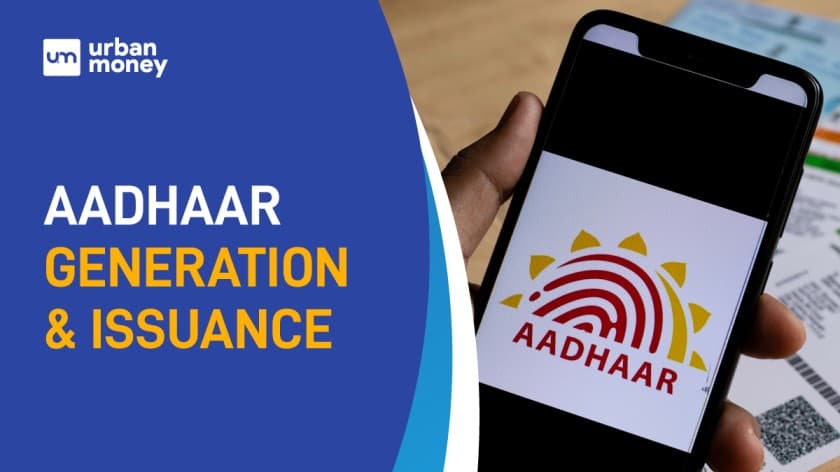- Home
- Adhaar Card
- Aadhaar Generation
What is Aadhaar Generation, and How is It Issued to Residents?

- Personalized solutions
- Expert guidance
- Application assistance
- Credit score discussion
- Interest rate comparison


Last Updated: 21 December 2025
An Aadhaar is a 12-digit unique identification number provided to every Indian resident by the Unique Identification Authority of India on behalf of the Indian Government. The sole purpose of launching the Aadhaar card was to equip citizens with a single document that can be used as identity proof, address proof, or even proof of age. But the question that arises here is: How do Aadhaar generation and its issuance work?
Various steps and factors are involved in the Aadhaar generation and issuance of an Aadhaar number. This blog will take a closer look at the process and issuance of the same.
Aadhaar Generation & Issue
Aadhaar generation is the process that involves packet validation, quality checks, biometric and demographic de-duplication, and more. The Aadhaar generation will only be successful if the following criteria are met:
- There’s no duplication of demographic information or biometric data.
- The enrolment packet qualifies all the verifications performed in CIDR.
- The quality of enrolment data satisfies specific standards set by UIDAI.
If the above conditions are not met, the enrolment will be rejected, and an Aadhaar number will not be issued. The processes resulting in Aadhaar generation have been described below.
Step 1: Uploading Resident’s Data to CIDR
Every resident enrolment comes in a kind of software packet encrypted after the client performs the enrolment process. Moreover, this packet is uploaded to the CIDR (Central ID Repository); using this upload, client data is provided to the Enrolment Agencies by UIDAI.
The uploaded packet records are stored in the client software. This is done to prevent duplicate packets from being uploaded to the server, saving processing time and packet rejection. A secure and protected file transfer Protocol is used to transfer all the data to the server. This, in turn, also prevents data leakage to any unauthorised agency. The documents obtained from residents are also scanned. After they are scanned, those documents become part of the enrolment packet, which is uploaded to the CIDR.
CIDR Sanity Checks: Every enrolment packet is thoroughly examined for validity – packet metadata, checksums, etc. in the CIDR DMZ with the help of an automated process before it is transferred to the production zone of CIDR for processing.
Data Archival: In CIDR, the packet contents are read and recorded in the table before archiving to ensure that the data is protected. The archival system demands the following requirements:
- All original packets (updates, enrolments, etc.) are supposed to be archived as-is and “forever”, guaranteeing zero data loss and high availability.
- The archival system may authorise on-demand data retrieval with proper approvals and access control.
- The archived packet is stored securely and isolated from authentication and core enrolment systems.
- Main Processing Pipeline.
- Regular backup of archived data is accepted to ensure no data loss.
After the sanity checks are cleared, the enrolment packet is transferred to the main processing pipeline. At a high level, this comprises the following phases:
Automated Data Validation
The following validation checks are performed in CIDR for demographic information:
- Name & Address validations
- Pincode and Administrative regions
- Operator, Supervisor, Introducer Validations
- Language Validations
- Other Data & Process Validations
Demographic Deduplication
Primarily, demographic deduplication is employed to detect trivial duplicates (non-fraudulent cases where all the demographic areas are identical) that are inadvertently provided to the system. For instance, when an Indian resident doesn’t receive the Aadhaar number after a few days of enrolment and decides to re-enrol at an enrolment station, then demographic deduplication is used.
It is also utilised for deduplicated kids under the age of 5 years as biometric data is not recorded for children as per UIDAI policy. Demographic deduplication aims to screen such cases and decrease the number of trivial duplicate approaches for biometric deduplication.
Manual Quality Checks
Enrolment/registration packets are sent for manual quality checks, where multiple quality check operators verify the data for photo quality and demographic issues. This comprises sanity tests against the resident photo – the gross errors in age and gender, the existence of human image, problems with the captured data (such as transliteration errors), and photo mismatch.
Biometric Deduplication
Once a packet approves all validations and demographic checks, it is delivered for biometric deduplication to the biometrics sub-system. ABIS (Automated Biometric Identification System) from three different vendors are used to guarantee the highest levels of performance and accuracy.
The vendors receive incentives based on their performance and accuracy to ensure that they continue improving their systems’ performance. These vendors receive anonymised biometrics of residents along with a reference number (generated in CIDR) without exposing the identity of the residents. The ABIS system matches the biometrics of the residents with all existing biometrics in their gallery to discover duplicates, if any.
Manual Adjudication
ABIS system identified all duplicates and then sent them to the adjudication module. This module’s goal is to ensure no resident registration is rejected because of any potential false matches of the ABIS systems.
Step 2: Aadhaar Issuance
The Aadhaar number is allocated after assessing the individuality of the resident. The demographic information of the resident is linked with this Aadhaar number. Hence, an Aadhaar number or the Aadhaar card can be used as identity proof. The allocated Aadhaar number is also delivered to the authentication systems so that the resident authentication can be completed successfully.
Step 3: Aadhaar Letter Delivery
Once the Aadhaar number is generated, the data is communicated to a print partner. The print partner is accountable for printing the letter, including tracking information and supplying the same to the logistics partner. The logistic partner (India Post) is then liable for delivering the physical Aadhaar card or the physical letter to the resident cardholder.
Frequently Asked Questions (FAQs)
What is Aadhaar generation?
Aadhaar generation is the process that involves collecting a user’s biometric and demographic information from an enrolment camp and then securing and verifying those details provided by the user extensively. This further includes several levels of screening. Once the screening process is over, the applicant is allocated a 12-digit Aadhaar number, which is communicated to the cardholder.
Is the Aadhaar number generated randomly?
Yes, an Aadhaar number is a randomly generated 12-digit number allocated to Indian residents. Once an Aadhaar is generated, it portrays complete demographic details of the cardholders along with their biometric information.
How long does it take for Aadhaar generation?
According to UIDAI, the process of Aadhaar number generation can demand up to 90 days from application. Once the process is completed, the applicants will receive their Aadhaar number or Aadhaar through the post. The Aadhaar number may also be communicated with the applicants on their registered mobile number. Or you can also download an e-Aadhaar card from the UIDAI website.
